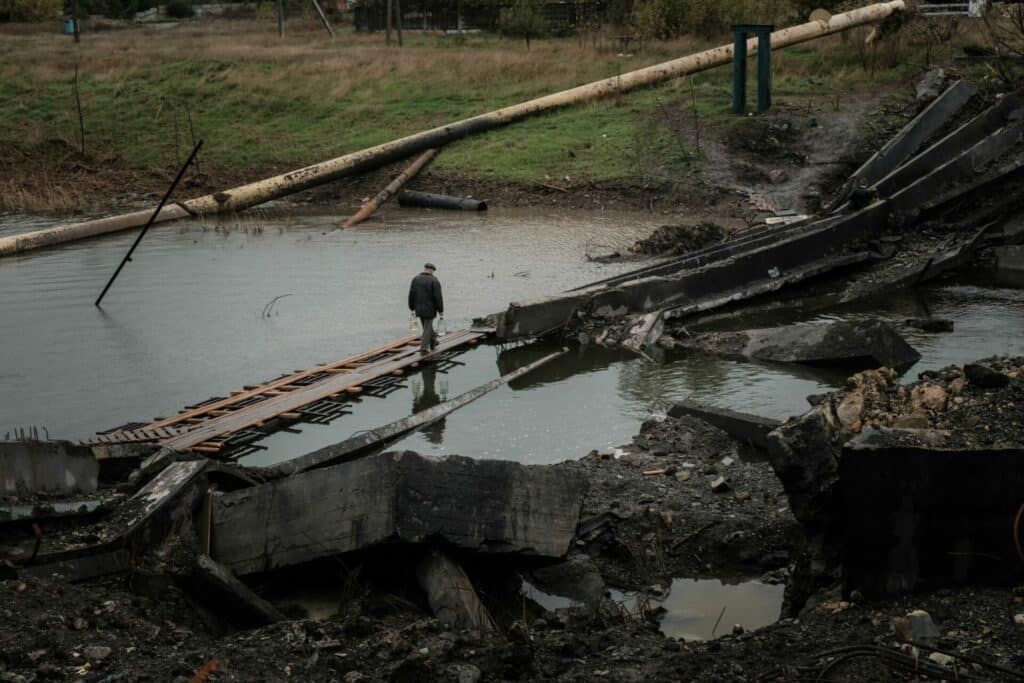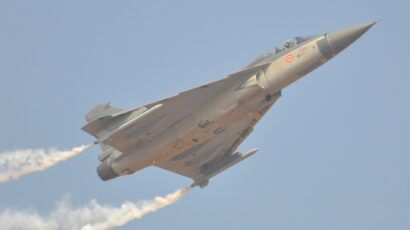Water as weapon, and casualty, in Russia’s war on Ukraine
By Peter Gleick | October 27, 2022
 A man crosses a destroyed bridge with water bottles in the Ukrainian town of Bakhmut in October 2022. Many communities have been under shellfire and without power or water for months.(Photo by YASUYOSHI CHIBA/AFP via Getty Images)
A man crosses a destroyed bridge with water bottles in the Ukrainian town of Bakhmut in October 2022. Many communities have been under shellfire and without power or water for months.(Photo by YASUYOSHI CHIBA/AFP via Getty Images)
The war in Ukraine that began in late February with the Russian invasion of the southern and eastern regions of Donetsk, Luhansk, Zaporizhzhia, and Kherson, and the attempted overthrow of the government in Kyiv, has many long and complicated roots. A critical issue, however, little addressed in the media, and little understood by the general public, is the role that fresh water has played in this conflict, and the impacts of the war on Ukraine’s water resources and infrastructure.
There is a long history of conflicts over water resources. The Pacific Institute has, for many years, maintained the best, open-source database on this issue: the Water Conflict Chronology.
This database tracks all known and reported water conflicts, where fresh water has been a trigger of conflicts or where water and water systems have been weapons or casualties of conflicts. Among the earliest entries are the century-long war between the ancient cities of Umma and Lagash in Mesopotamia, 4,500 years ago, and attacks on water and irrigation systems during the long history of the Assyrian, Babylonian, and Sumerian empires. But the number and severity of water conflicts has accelerated dramatically in recent years, as population and economic growth has put more pressure on limited water resources, climate change has intensified extreme hydrologic events, and inter- and intra-state conflicts have expanded. The Russia-Ukraine war offers just the latest examples.
In early October, Elon Musk inserted himself into the issue when he proposed four conditions for “peace” between Russia and Ukraine. Three of those conditions related to his opinion about borders, political conditions, and public elections, and they have been roundly discussed. But one of the conditions has been mostly ignored. This proposal was to assure “water supply to Crimea.” How did that oddly specific demand sneak in there?
It turns out that Crimea’s water supply is heavily dependent on a canal—the North Crimea Canal—that takes water from the Dnieper River near the town of Nova Kakhovka and distributes it though the Kherson region and into Crimea. Most of the water is used for irrigation. The Dnieper is the fourth longest river in Europe, rising in the Valdai Hills of Russia, flowing through Belarus, into Ukraine past the capital of Kyiv, and south, emptying into the Black Sea.
When Russia illegally annexed Crimea in 2014, Ukraine built a dam across the canal to cut off the water supply, disrupting agriculture, straining reservoirs, and causing chronic water shortages in the years that followed. In the very first days of the Russian invasion of Ukraine this year, the Russians blew up that dam, an indication of the strategic value of water to Crimea and a key objective of the Russian invasion.
As a result, the peace plan that Musk proposed, to “assure” the water supply of Crimea, would—if Russia retains its hold on Crimea—require that Russia annex and keep the Kherson region and retain control over the entire canal. It is worth noting as well that the timing of the Musk proposal coincided with a major Ukrainian offensive pushing directly toward Kherson and Nova Kakhovka, and accepting that proposal would require the Ukrainians to halt their new offensive.
Each of the pieces of that proposal is a key Russian demand and, of course, a complete non-starter for Ukraine. In an uncharacteristically blunt response, Ukraine’s outgoing ambassador to Germany, Andrij Melnyk, said “F___ off is my very diplomatic reply.”
But water has played other critically important roles in the conflict as well. In the early days of the war, as Russian armored forces were moving toward Kyiv, the Ukrainians cut a levee, flooding a large area of land and helping to stop that assault. This action is reminiscent of the strategy the Dutch used in 1573, flooding land to break the siege of Spanish troops on the town of Alkmaar, and a year later to protect Leiden.
Ukraine’s water purification, delivery, and wastewater infrastructure has also suffered a series of intense attacks, cutting off access to safe water and sanitation for millions of civilians. Working with colleagues from Germany, Belgium, and the Ukraine on this issue, we documented more than 60 instances between February and April 2022 where civilian water supply and water treatment has been disrupted, pollution of surface waters has been worsened from disrupted mine operations and sunken and destroyed military equipment, and dams for both water supply and hydroelectric power have been attacked. As long ago as last April, the United Nations reported that six million Ukrainians were struggling to get access to safe drinking water, and conditions have worsened since then. Intentional attacks on power plants have also cut access to the energy needed to operate basic civilian water and wastewater infrastructure.
Attacks on civilian infrastructure critical for human health and wellbeing are violations of the Geneva Conventions. Specifically, the use of water as a weapon of war, or targeting civilian water infrastructure such as water supply or water treatment plants, or attacking dams and irrigation systems, are war crimes under the 1977 Protocols. Articles 51 and 54 of Protocol I of the 1977 Geneva Convention prohibit indiscriminate attacks on civilians and civilian infrastructure and they protect infrastructure critical to the survival of civilian populations. This international law states “it is prohibited to attack, destroy, remove or render useless objects indispensable to the survival of the civilian population, such as foodstuffs, agricultural areas for the production of foodstuffs, crops, livestock, drinking water installations and supplies and irrigation works, for the specific purpose of denying them for their sustenance value to the civilian population or to the adverse Party, whatever the motive, whether in order to starve out civilians, to cause them to move away, or for any other motive [emphasis added].”
The law also states that militaries are to avoid attacking such installations so as not “to leave the civilian population with such inadequate food or water as to cause starvation or force its movement” (Protocol I, Article 54), while Article 56 of Protocol I and Article 15 of Protocol II prohibit attacks on infrastructure “containing dangerous forces” including explicitly “dams” and “dykes” if such attacks “may cause the release of dangerous forces and consequent severe losses among the civilian population.” On October 20, Ukrainian president Zelensky called for international observers at the Kakhovka Dam in Kherson, saying that Ukraine had evidence Russia had mined the dam and was prepared to blow it up, which would cause devastating flooding for 80 downstream towns and cities, disrupt the water supply for southern Ukraine, and potentially cut off critical cooling water for the Zaporizhzhia Nuclear Power Plant.
Information and data on the consequences of the war for civilians, the environment, and water resources continues to accrue, but the full cost is still unknown. I urge all parties to refrain from violating international laws protecting civilians and the environment, including especially the water resources and water infrastructure critical for protecting human health and wellbeing. And the international community must do its part to ensure these rights and resources are protected and violations and violators punished.
Together, we make the world safer.
The Bulletin elevates expert voices above the noise. But as an independent nonprofit organization, our operations depend on the support of readers like you. Help us continue to deliver quality journalism that holds leaders accountable. Your support of our work at any level is important. In return, we promise our coverage will be understandable, influential, vigilant, solution-oriented, and fair-minded. Together we can make a difference.
Keywords: Russia-Ukraine, Ukraine, Ukraine conflict, Ukraine crisis, drinking water, environmental impacts of war, water, water crisis
Topics: Climate Change, Nuclear Energy















